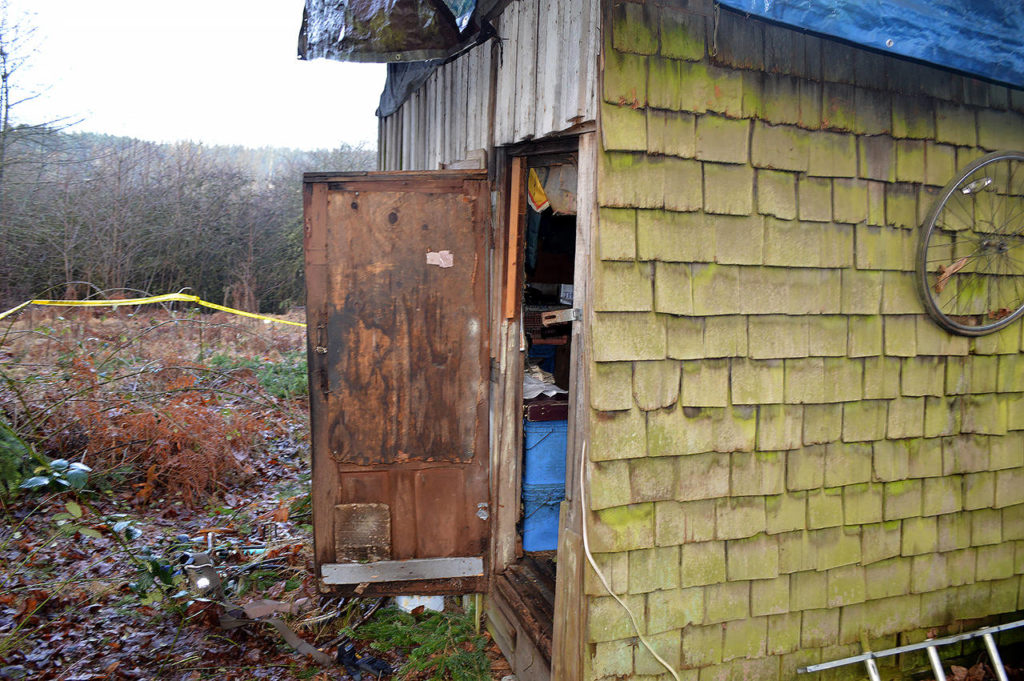MILL CREEK — Years ago, a dentist found a starving man in his apple orchard.
He gave him something to eat and nursed him back to health. The homeless man told him he’d once been a guard at a New York bank, but he’d been hit over the head in a robbery. The dentist let him sleep in a one-room shed behind his house on the outskirts of Mill Creek. He worked on the man’s teeth and sometimes even asked him to babysit. His family rented out the house, telling tenants the neighbor in the shed came as part of the deal.
At least that’s the strange tale gathered by authorities since Jan. 11, 2015, when a passerby found a body in an overgrown shack along North Creek Park.
Apparently police had come in contact with the man before, and written his name as Jerry Diggs, born in May 1945; or Jerry Deggs, born in December 1949; or Jeremy Diggs, born on New Year’s Eve 1950. All were close to the truth, but not near enough to lead to his family, to tell them he had died.
His real name remained a mystery until volunteers at DNA Doe Project cracked the case over the past 1½ years. Amateur genealogist Jenny Lecus, 35, grew obsessed with the nameless man.
“He was my first and last thought every day for 19 months,” Lecus said Friday.
If she listened to music, she’d wonder what songs he listened to. She wondered about his likes and habits, and what kind of stories he would tell.
In large part thanks to hundreds of hours of sleuthing by Lecus, the Snohomish County Medical Examiner’s Office is officially releasing the man’s name Monday.
She still has many things she would like to know about Nathaniel Terrence Deggs.
A large family
On the East Coast, he went by Terry, not Jerry.
He’d been born to a teenage mother in Baltimore, the second of more than a dozen brothers, sisters and half-siblings. In his youth, he was taken in by a foster mom whose last name was Deggs. They moved to the Bronx.
Little is clear about this part of his life. The siblings knew of each other, but weren’t always in touch. One of his sisters told authorities she’d visited him in New York City. She recalled seeing him in the uniform of a bank security guard. His foster mother died in 1984. Family believed he was extremely upset by the loss. Not long after that, he vanished.
His family searched for him over the years. Yet he existed about as far off the grid as a person can these days, in spite of being perhaps a half-hour drive northeast of Seattle. Why he came here, of all places, is an enigma.
The Mill Creek man discovered the cold, emaciated African-American man in October 1985, staying in a falling-apart barn near his home in the 17500 block of Bothell-Everett Highway. He became a part of the family, cooking for them.
The man went by Jerry. He was reclusive, rarely leaving the shed about 200 feet behind the home. Renters knew a man lived back there, but they learned little about his past.
James K. Prater, 57, a contractor now based in Clearview, rented the place for a year around 1996. He also knew his backyard neighbor as Jerry, a quiet guy who was “kind of slow.” He’d make childlike sketches of his surroundings in color. On holidays Prater would bring him a plate of food, and if Prater was chopping firewood, he’d share the extra.
One day a small fire broke out on the roof of the small cabin. Prater grabbed a ladder and put out the flames. Firefighters would not allow Deggs to keep his wood stove, though. Prater gave him an electric skillet and a small heater, and ran the power cords out of his home business, a paintball shop.
Prater recalled Jerry did odd-jobs for the homeowner — mowing the lawn and other landscaping work — on the other side of the valley. For the most part Jerry just kept to himself. He liked to eat potatoes and he lived off the land, picking fruit from the orchard, on a quiet 6 acres, Prater said.
“He just wandered around in those woods,” he said. “There’s birds, there’s coyotes. They’re developing it, which is ruining the luster.”
Prater had given him seeds to try to grow a garden. Deggs wasn’t very good at it. He joked that if he had to grow his own food, he’d die. He had no phone and no running water. Once in a while he’d walk to the house to fill up from the spigot.
After the dentist’s father died, the property was transferred to a company co-owned by his sons in 2007.
Several times after that, Mill Creek police documented a man walking along Bothell-Everett Highway. Officers scribbled quick reports when they talked with him, but he was never arrested, fingerprinted or caught in any serious trouble.
Prater continued to drive past the house on his regular trips to Snohomish County. Once, he said, he’d even taken back some of the flowers he planted in his former garden.
“I had no idea that the old man was still living there,” Prater said.
A nameless man
Brambles covered the shed by the time the body was found in 2015, under blankets on a mattress made of pieces of foam. Inside it was undisturbed, with $20 left untouched, police reported.
The nameless man wore dark heavy wool socks. He’d dressed in a plaid flannel shirt, a black T-shirt with a high collar and tan pants. He was missing a tip of one finger. Authorities later learned Deggs had an accident while chopping wood as a boy. Foul play was never suspected in the death. Over several trips, police searched fruitlessly for some piece of ID.
DNA from the remains had been entered into the national database CODIS as early as 2015. There were no matches.
Death investigators took many approaches to find the man’s name. They asked the state Department of Social and Health Services to look for records of food stamps that could be linked to him. But there was no evidence he used them.
Once investigators learned of the similar, inconsistent names in old police field reports, the medical examiner’s office gave those clues to Oregon genealogist Deb Stone. She uncovered a promising lead in an East Coast man, who shared one of the names and was born in the 1940s. But he was still alive.
A forensic dentist compared the man’s teeth to those of missing people. But he struggled to narrow down a list of possibilities.
Cans and over 1,000 pieces of paper were recovered from the cabin in 2015, to be tested for fingerprints. Only two sheets came back with workable samples. And neither of the prints matched any person who was reported missing. Those prints may not have come from Deggs anyway, because his fingers were possibly too dry to leave behind a mark.
Articles in The Daily Herald showed a likeness of the man’s face, a forensic drawing based on the man’s skull. Every tip from the public led to a dead end.
The first step that led to an actual answer came in early 2018. A new DNA sample had been extracted from the man’s femur, to be used by the nonprofit DNA Doe Project. The genetic profile was uploaded to the ancestry site GEDmatch, a database that has become a key resource in the fast-emerging field of forensic genealogy.
Researchers use near-matches on the site to track down relatives, and ultimately, they can pinpoint the person in question. Using crime scene evidence, police have worked with genealogists to crack high-profile cold cases over the past two years, including two long-unsolved killings in Snohomish County.
Genealogists have also helped the Snohomish County medical examiner to restore names to an unidentified man found dead in Yost Park in 2018; a piece of human skull caught up in the Skykomish River in 2017; a mostly complete skull recovered from the woods in the Tulalip area in 2016; and a skeleton uncovered near Lynnwood in 1978.
Some cases can be solved in a couple of hours by the DNA Doe Project. Often it takes months. This one took the most time, by far.
For about 1½ years, the case became a puzzle for Lecus, a genealogy hobbyist from Franklin, Wisconsin. She’s been fascinated with ancestry since age 14, when she used her Christmas money to buy a family tree-building program.
Lecus has traced her own bloodlines back to the 1700s in Germany. She submitted her own DNA to Ancestry.com in 2016, and instantly she was hooked by a new approach to a lifelong passion. She has volunteered with the DNA Doe Project since it was founded in 2017.
For about a year, there were no close family matches for the person known as the Mill Creek Shed Man. Generally it takes a second cousin or closer to build a tree from scratch. All of this John Doe’s matches were around the fifth-cousin level, back in 2018.
On GEDmatch, users can click a box to let researchers or police view their genetic profile, a recent policy change reacting to concerns over genetic privacy and informed consent. On the downside, it made things much harder for forensic genealogists, and Lecus encouraged anyone signed up for the site to “opt in,” to help solve cases like this one.
Each day Lecus logged in to check up on handful of profiles she’d been monitoring on GEDmatch, to see if close relatives would pop up. Then one morning in February, a half-cousin shared her profile. She was a blood relative of Deggs’ mom.
A mystery in a mystery
In public records, the name Terry or Jerry or even Nathaniel Deggs is about as elusive as the man himself.
One relative had his Social Security number, but it proved to be little to no help.
The family had hired a private detective at one point, and tried their own internet searches.
His birth certificate still has not been found — that particular year was missing in Baltimore’s public records when Lecus went looking for it, she said. Deggs was likely nearing 65 years old when he died.
One obituary of a brother called him Nathaniel Davy in 2017. Nathaniel was listed as a survivor. Another obituary gave the last name Davis. Since then, some family members have suggested it was a combination of the two. In spite of the confusion, if his siblings hadn’t published those names, researchers would still be guessing, Lecus said. The DNA Doe Project volunteered over 1,900 hours in search of the name, affixing thousands of branches to hundreds of family trees. Once Lecus had the half-cousin’s name, she was able to discover pieces of his ancestry. It led her to the obituaries.
Everyone on that long list of siblings could be found without much trouble — except for Nathaniel. Later, DNA from one of the sisters would confirm Deggs was the man in the shed.
“I still check every day for new matches,” Lecus said. “I do hope to have some more of his tree filled in. It’s a personal thing.”
One night in August, one of Deggs’ half-siblings answered a phone call from a strange number out of the Seattle area.
There was a bit of an edge in the woman’s voice, the kind of tone you might give a rude telemarketer, recalled Jane Jorgensen, the investigator at the medical examiner’s office. It was only 7 p.m. on the West Coast, but it was hours later on the other side of the country.
Then Jorgensen told her why she was calling. The woman’s voice softened. She’d been waiting a long time for this.
Caleb Hutton: 425-339-3454; chutton@heraldnet.com. Twitter: @snocaleb.
This story has been modified to more precisely describe the nature of the change of ownership of the house in 2007.
Talk to us
> Give us your news tips.
> Send us a letter to the editor.
> More Herald contact information.




























